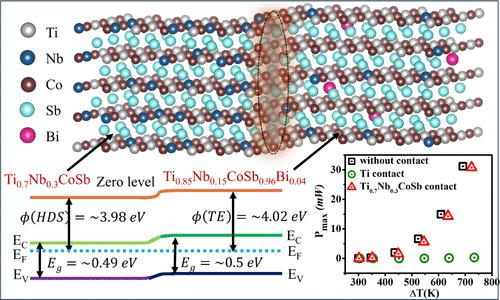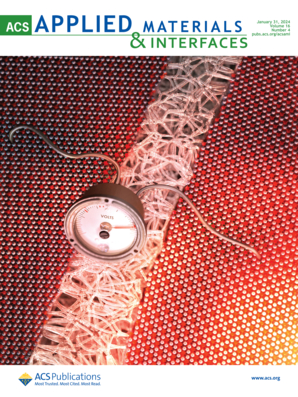n型ticosb基热电器件的低界面电阻良好接触
IF 8.2
2区 材料科学
Q1 MATERIALS SCIENCE, MULTIDISCIPLINARY
引用次数: 0
摘要
在过去的十年中,人们已经做出了巨大的努力来开发高效的半赫斯勒(HH)基热电(TE)材料。然而,由于在TE器件制造过程中出现的各种挑战,特别是开发具有低界面电阻的稳定接触,它们的实际应用仍然有限。在本研究中,我们努力探索一种稳定的低界面电阻接触材料,用于n型ticosb基TE材料,以Ti0.85Nb0.15CoSb0.96Bi0.04为概念验证,采用简单易行的火花等离子烧结合成路线。我们测试了许多与TiCoSb具有相容热膨胀系数的金属,如Fe和Co,但我们仍未能与TE材料形成适当的原子键。相比之下,钛金属正确结合,但表现出非常高的电接触电阻(一侧为~ 300 mΩ),由于Ti扩散和界面处的高势垒而降低了性能。通过高掺杂半导体(HDS)触点Ti0.7Nb0.3CoSb解决了这一问题,该触点在原子键合、晶体结构和稳定性方面与TE材料相匹配。具有HDS接触的腿具有优越的电子传输性能和低界面电阻(一侧为~ 15 mΩ),由于具有低势垒高度的锐界面,在ΔT = 451 K时实现了30.7 mW的最大输出功率。这些发现表明,使用HDS材料作为相同HH TE材料的接触将是开发具有低界面电阻和高热稳定性的TE器件的有效途径。本文章由计算机程序翻译,如有差异,请以英文原文为准。

Favorable Contact with Low Interfacial Resistance for n-Type TiCoSb-Based Thermoelectric Devices
In the past decade, significant efforts have been made to develop efficient half-Heusler (HH) based thermoelectric (TE) materials. However, their practical applications remain limited due to various challenges occurring during the fabrication of TE devices, particularly the development of stable contacts with low interfacial resistance. In this study, we have made an effort to explore a stable contact material with low interfacial resistance for an n-type TiCoSb-based TE material, specifically Ti0.85Nb0.15CoSb0.96Bi0.04 as a proof of concept, using a straightforward facile synthesis route of spark plasma sintering. We tested many metals with compatible coefficients of thermal expansion to TiCoSb, like Fe and Co. Still, we failed to form proper atomic bonds with the TE material. In contrast, Ti metal bonded correctly but showed very high electrical contact resistance (∼300 mΩ at one side), reducing performance due to Ti diffusion and a high potential barrier at the interface. This issue was addressed by highly doped semiconductor (HDS) contact Ti0.7Nb0.3CoSb, which matched the TE material in terms of atomic bonding, crystal structure, and stability. The leg with the HDS contact demonstrated superior electronic transport performance and low interface resistance (∼15 mΩ at one side), achieving a maximum output power of 30.7 mW at ΔT = 451 K due to the sharp interface with a low barrier height. These findings suggest that using HDS material as a contact with the same HH TE material would be an effective way to develop a TE device with low interface resistance and high thermal stability.
求助全文
通过发布文献求助,成功后即可免费获取论文全文。
去求助
来源期刊

ACS Applied Materials & Interfaces
工程技术-材料科学:综合
CiteScore
16.00
自引率
6.30%
发文量
4978
审稿时长
1.8 months
期刊介绍:
ACS Applied Materials & Interfaces is a leading interdisciplinary journal that brings together chemists, engineers, physicists, and biologists to explore the development and utilization of newly-discovered materials and interfacial processes for specific applications. Our journal has experienced remarkable growth since its establishment in 2009, both in terms of the number of articles published and the impact of the research showcased. We are proud to foster a truly global community, with the majority of published articles originating from outside the United States, reflecting the rapid growth of applied research worldwide.
 求助内容:
求助内容: 应助结果提醒方式:
应助结果提醒方式:


